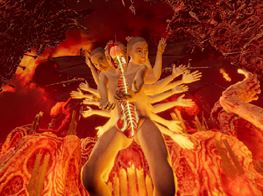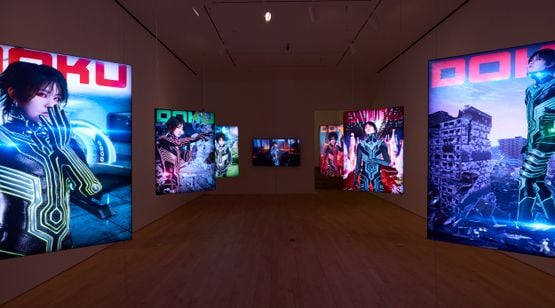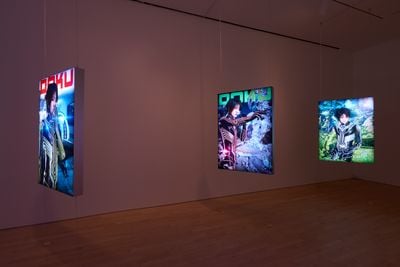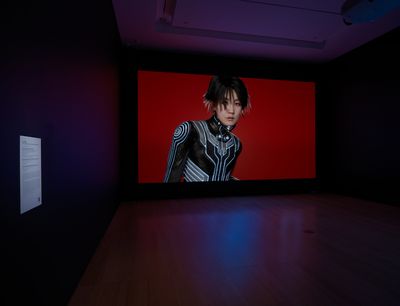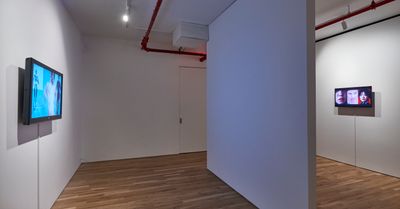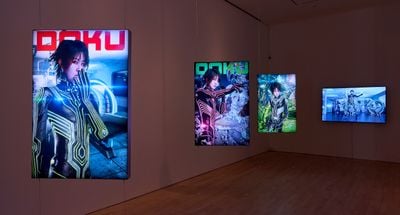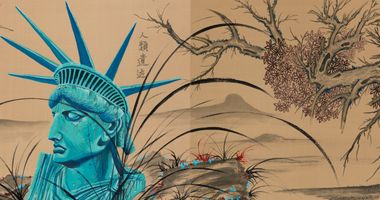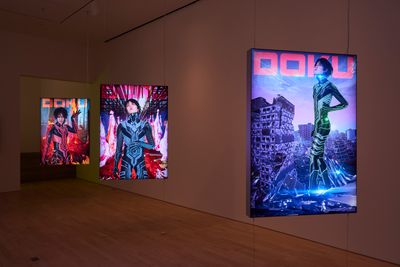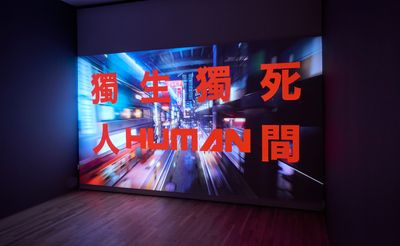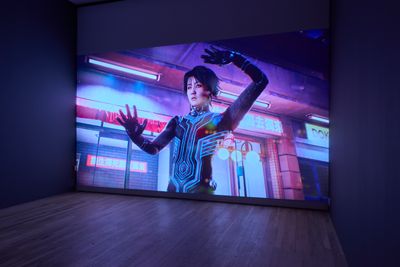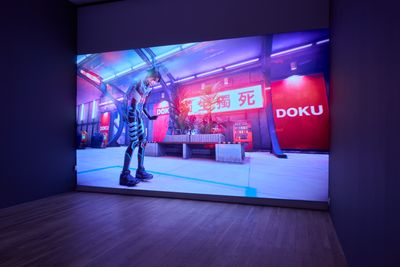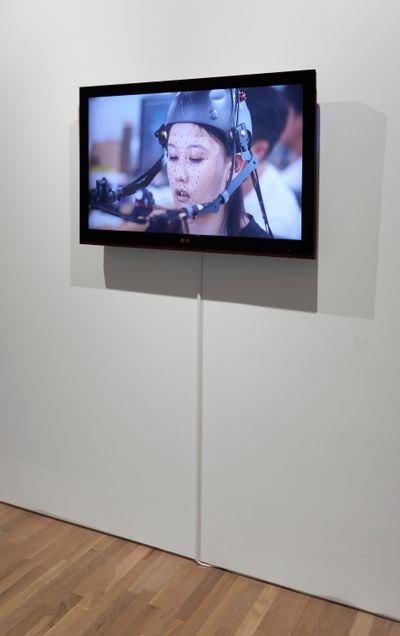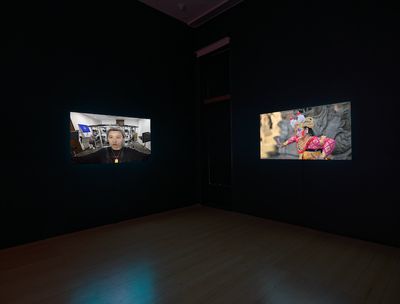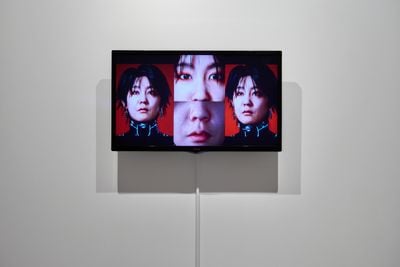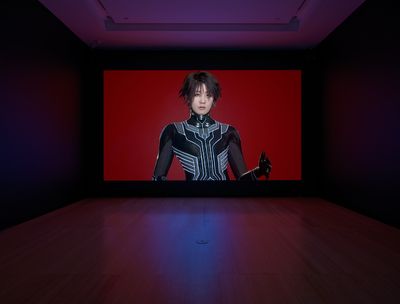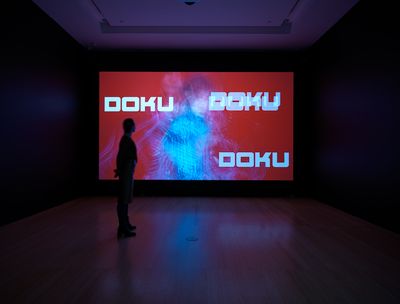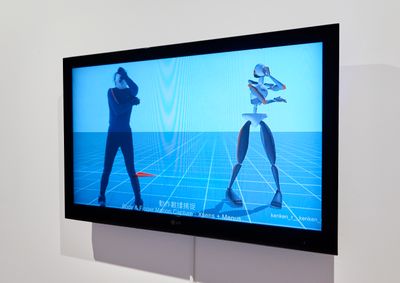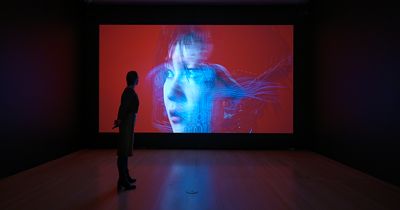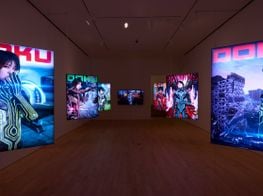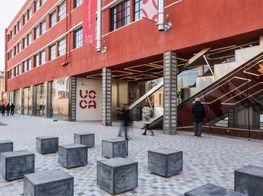Lu Yang Imagines
Reincarnation in a Virtual World
In Partnership with Jane Lombard Gallery
Lu Yang. Courtesy Beijing Commune.

Lu Yang. Courtesy Beijing Commune.
Graduating in 2010 from the China Art Academy in Hangzhou, Lu Yang is one of the most innovative artists working in China today.
In Hangzhou, Lu Yang studied under video art pioneer Zhang Peili, the founding chair of the New Media Art department at the China Art Academy, where she received her MA. Just a year after graduating, she was invited to exhibit at Beijing's UCCA Center for Contemporary Art, where Zhang Peili curated her work in The Anatomy of Rage (24 September–20 November 2011).
Combining a video with an electronic soundtrack depicting the Tibetan Buddhist god Vajrasattva rendered through 3D modelling and medical diagrams, the exhibition unpicked the deity's 'physical and spiritual anatomy', shown alongside traditional scroll drawings in the space. The Anatomy of Rage demonstrated the artist's unique blend of traditional practices with cutting-edge technology, which she has continued to explore in video works and motion-capture performances presented in solo and group presentations around the world.
Most recently, the artist was included in Part 2 of the Asia Society Triennial, We Do Not Dream Alone (26 March–27 June 2021), with the newly commissioned Dokusho Dokushi Hello World (2021), a game engine-rendered animation of the artist's gender non-binary digital avatar Doku on a quest for enlightenment. Doku is also present in the artist's current solo exhibition at Jane Lombard Gallery in New York (Doku: Digital Alaya, 7 May–19 June 2021), where Buddhist ideas combine with Japanese anime and interactive video games to consider the cycle of life in the post-human world.
In this conversation, which originally took place online on 3 June with the exhibition's curator, Barbara Pollack, and Michelle Yun Mapplethorpe, Asia Society's Museum Director and VIP of Global Artistic Programs, Lu Yang expands on the concept of reincarnation in the digital realm, along with the themes that run through her practice more broadly.
BPLu Yang, how did you come up with the avatar Doku, and what does this exhibition mean to you?
LYI started to use myself as an avatar in my work from 2015 with Delusional Mandala. From that time, I wanted to make a more realistic digital human who is asexual or without gender. I call him 'he', and in this virtual world, he can do anything.
Alaya is a Sanskrit word that means consciousness. It's like a seed; a seed for storing the karma from our different reincarnations. Nowadays, our world is more virtual, and we can embody and customise different avatars.
In Buddhism, there's the idea that nothing is real, whether it's in the digital or physical world. You can't touch it; it's like a bubble or a dream. Based on this concept, I don't think digital worlds are fake. They're real.
From the beginning of last year, I collaborated with a technology company to make a very realistic model of my face, and developed different costumes, hairstyles, and other elements, in a digital world. The virtual arena provided a real-life reincarnation—a Digital Alaya.
BPI'm very interested in this idea of using the digital to explore Buddhist ideas. Do you feel that the digital is replacing religious ideas or strengthening them?
LYIt's not so extreme as replacing them. In Buddhism, there's the idea that nothing is real, whether it's in the digital or physical world. You can't touch it; it's like a bubble or a dream. Based on this concept, I don't think digital worlds are fake. They're real.
BPMichelle, I wanted to bring you into this conversation and ask you about your interest in wedding ancient Asian culture with cutting-edge digital technology.
MYI think the inspiration for so much contemporary art is rooted in the historical and the traditional. And I think in many Asian cultures, there is a nice continuum between what is considered pre-modern and contemporary. Lu Yang has masterfully intertwined those, and really showed how within our cultures and within popular culture, there are very fundamental relationships between contemporary and more historic and traditional material.
When you see the videos at Jane Lombard Gallery, as well as the video that she created for the Asia Society Triennial, at first you're seeing this very slick, urban dance video, and the movements are very contemporary.
But when you see the documentary of how Lu Yang created the dance moves and how she synthesised traditional tattoo artistry with the very precise movements of Indonesian traditional dance practices, you see how contemporary art, culture, and life is infused with the past in such a beautiful way.
BPLu Yang, you seem to be very interested in cultures from all over Asia.
LYYes, I'm inspired by a lot of Asian traditional cultures.
BPI couldn't make out which city it is in the film, Doku – Hello World – Human (2021).
LYIt's actually a model that I found on the internet. I bought the whole city model at UE Marketplace. In this model, Doku is sometimes depicted as huge. I was inspired by science fiction, like Godzilla or Ultraman. Doku is a gigantic hero, fighting in the city. I put the camera in different positions, from the ground to the sky. It's like a set film camera set up.
MYDoku doesn't have a physical visceral existence. Do you think that in this virtual space, transcendence in the Buddhist sense can still be attained without the physical aspect?
LYIn the virtual world, we don't have the physical body and I think for now, people mostly experience the world through their brain. In technology, we can use a brain-computer interface to make the experience more realistic. I play role-playing games, and if the game is very good, you can just put yourself into character. During those kinds of moments, it's really like you're transferring your consciousness into another avatar or realm.
BPWhat I always find fascinating about your work is that these avatars are transgender, transnational, and they transcend the limitations of the human body. And in a way, the digital is allowing us to perfect something that may have been an idea for a long time, but now we can realise it visually. Michelle, in terms of the idea of fluid identity, are you seeing that in the work of other Asian artists?
MYDefinitely, because there is more of a societal openness about one's gender or self-identification that there are more artists that are feeling more comfortable about expressing their gender exploration through their artwork. Anne Samat, who's a transgender artist from Malaysia and was included in Part One of the Asia Society Triennial, is also exploring ideas of identity within Asian cultures.
It would be interesting to think about it in terms of identity politics from the nineties in the United States, thinking about how that has evolved to this moment of equity and inclusion. I think it's similar, but maybe kind of faceted in a slightly different way, but certainly I do see a lot of that expression going on.
BPLu Yang, do you see a difference between when you're making work to be shown in China or elsewhere in the world? Or is that a question you never think about?
LYI mostly don't care too much about the specific audience. I make whatever I want and I can track whether people are interested in my work. That's all.
BPHow big is your team?
LYI don't have a steady team. If I want to work on a project, I invite people to get involved.
Every year, I receive several articles or some people's graduate essays that mention my work. I remember one in particular, a student from Canada, who became a Buddhist after following my work.
BPIt was very interesting to me when I first met you, you were already on chat rooms all over the world, talking to scientists and technicians, musicians and animators. You do that so effortlessly.
LYI have interests in different cultural fields; so I listen to music, and I like a lot of books, about different things such as philosophy and forensic science. My interests are spread all around. And if I have some ideas, I just give it a try, and try to reach people and apply for funding. You have to try to give your idea to someone to see if it's possible to do something.
BPMichelle, what should we be noticing about Lu Yang's use of teams and production? This is very different from the artist in their studio. This is on another level.
MYIt is very different, but she's also harnessing these collaborators as a vehicle to manifest her vision. I think it's similar to how minimalists like Dan Flavin or Donald Judd had these concepts, and had things fabricated.
Even though it's in this virtual technological sphere, I think it has that same rigueur of the concept. Then it's about finding an avenue to accurately and faithfully manifest the concept that has been envisioned. I think she's very savvy in doing that, and really harnessing collaborators to manifest her ideas.
BPWhat have the reactions been to the work at Asia Society?
MYI think people are really impressed with the level of meticulous detail and rigueur in terms of the mastery of the technology used. But I think, also, the spirituality that Lu Yang brings to the work and the ideas in relation to gender, identity, and our souls, and these existential ideas of life and death. And this sense of pure being. I think this is really impressive to people.
BPA whole range of people have responded to this work at the gallery, even friends that I thought were going to hate the show came in and were won over by it. What we can't communicate in this virtual walkthrough is the detail and the beauty of the images is really astounding. To come in and go close and look at them is a whole other experience.
MYI think also what you touched upon earlier, Barbara, regarding the cross-cultural interests that Lu Yang has, I think that really alludes to how there is so much cross-cultural influence in societies. We're not in these little silos; there is real dialogue between societies and between temporal chronologies in terms of past and present.
BPYes, but I think many people in the States aren't as aware of the dialogue that is going on across Asia. This work is a good way of introducing people to that. If you've seen a Quentin Tarantino movie, you know, the way he mixes and matches samurai and techno and all of these things—it has penetrated our society to blend all of this stuff. And I think the digital and the internet has only moved that forward. Lu Yang, what would your life have been like if you never had the internet?
LYWhen I was very young, there was no internet. And during that time, I watched a lot of manga and music videos. When I was a kid, I watched so many videos from the U.S. and Japan. Music is important to me, as well as manga. It's a way to bring you into another world.
BPHas Japan influenced you? You've travelled there extensively, correct?
LYYes, I watch a lot of animation. I went to Japan frequently before Covid.
BPYou worked with Japanese musicians for both Doku – Digital Alaya, Doku – Hello World, and Doku – Hello World - Human, correct?
LYI worked with the producer of Hatsune Miku, who is a very famous virtual idol. His name is Utsu-P and he makes odd music.
BPHow do you get access to these people? That always amazes me about you.
LYI collaborated with a Japanese art center called Spiral. They support me a lot on many different projects.
BPIs there anything else you want to tell us about the work in Doku: Digital Alaya?
LYFor the facial capture used to create the video, I collaborated with a company called FACEGOOD. We brought the team from China to Indonesia. The facial capture is from Indonesian dancers, who use their facial muscles to dance. I think of this as a new way to record our human history; the history of movement. That kind of dance is almost beyond human. It's very hard to do.
BPThat's very interesting that you're talking about the history of movement, because most people, when they hear the term facial recognition, they're a little scared of it.
MYI think it's interesting, your concern with preserving intangible heritage, like dance, or, you know, different visual art that you can't put in a museum. It's more difficult to preserve those art forms. And so I think it's very thoughtful of you to integrate it in your work with that perspective.
LYWith technology, even if you can't dance or move, you can do whatever you want in the virtual world. You can make a perfect version of yourself.
That kind of dance is very rare. You can only see it in Bali. We invited the most famous dancers from Bali and they gave us a lot of dance data. But in this show, and also at Asia Society Museum, the dance movement is from a Japanese contemporary dancer called KenKen.
After this, I will use more dance data from those Indonesian dancers. Their dance history spans thousands of years, and has a vast cultural background. They're influenced a lot by Hinduism and ritual cultures. So I think it's a new way to connect to the past.
MYIt's like a form of storytelling.
BPLu Yang, is Doku a perfect avatar of you?
LYYeah. I wanted to make a perfect avatar, and then use Doku as a connection, hopefully with more artists. Anything is possible when you collaborate with many people.
BPMichelle, when you first encountered Doku, how did you view him as an expression of an artist of their own persona?
MYI think it's really this sense of liberation. I think what Lu Yang was expressing earlier about this post-gender figure. Being in this virtual realm is limitless, where you can really express yourself and explore the infinite possibilities of life. I think it's very freeing. It's interesting with some of her other works in the Asia Society Museum collection, much thanks to you Barbara; we have the video game Uterus Man (2013), which is interactive.
Visitors can interact with Uterus Man in this space. But with the version of Doku that we have at Asia Society, Doku is in this bare, red environment that's just completely limitless. So I think it's a really big jump in terms of thinking about this avatar to express creativity and infinite possibility.
BPThat is so interesting to me, because when I look at her work, the technology intimidates me a little bit. I don't think of the computer as liberating, but I think for her generation, the introduction of the internet was vastly liberating. You feel that energy in the work itself.
MYIt just pulsates with life, which seems very counter-intuitive, right, because when I think of technology, and I think of science and equipment, it's more constraining, but I feel with Lu Yang's work, that it is very organic in a lot of ways. I think maybe it's with some of the subject matter that she's dealing with the body and heaven and hell, in terms of, for example, delusional crime and punishment, where you're exploring the afterlife. I do think it opens things up rather than constricts them inwards.
BPI just want to add that Lu Yang has been exploring questions around life and death in the digital realm throughout the course of her career. It's not new. She had Uterus Man, who was an androgynous, non-sexual superhero who used female reproductive organs to defeat their enemies. And she's also done much work with neuroscientists about the brain chemistry of Buddhist gods and how new technology may eliminate things that meditation hasn't exactly eradicated from the human race. So, her long-term commitment to these things is very interesting to me. John [Freeman], do we have questions?
I play role-playing games, and if the game is very good, you can just put yourself into character. During those kinds of moments, it's really like you're transferring your consciousness into another avatar or realm.
JFOkay. So we have a question from Ellen. Lu Yang, have you thought about doing this as VR, so participants could experience these realms spatially in these non-gendered, non-racial forms?
LYYes. In 2019, I created a game called The Great Adventure of Material World and it has a small VR version. Everything is created based on the game engine, so it can export into any platform, not only VR—we can do it in versions for AR, PS4, PS5, or PC.
Presenting a VR game at a gallery is not something so many people can experience. Only one person can experience it at a time, for example, otherwise you need more computers. My work has very high-tech needs.
JFAnd we have another one from Josie. Lu Yang mentioned her interest in philosophy. Her work makes me think of the philosopher John Dewey and his work on self-transformation. Can she tell us which philosopher she's currently looking at?
LYIt is mostly inspired by Buddhism, particularly the vajra sutra and the heart sutra.
BPI think what's interesting about Josie's question is that this idea of transformation and self-transformation is actually a universal exploration. Forms of this have been explored by cultures all over the world, and Lu Yang sort of brings those things together. So I think people from everywhere can relate to the cycle of life that she's conveying in her work.
MYYes. I'm curious, Lu Yang, when you're thinking about the heart sutra or Buddhist ideas and transposing that into the virtual space, do you think that the interpretation shifts? Or do you think that you're updating these ideas for an audience that is filtering information through different technological channels?
LYI have a lot of inspiration from Buddhism, and I get some feedback from the audience. Every year, I receive several articles or some people's graduate essays that mention my work. I remember one in particular, a student from Canada, who became a Buddhist after following my work.
BPI love how you think of narrative in terms of gamer culture. You do that so wonderfully. And of course, that is the way stories are being told now.
LYGames can be very immersive, and you can walk around a different world, and you can enter an artist's world, instead of just watching it.
BPHave Buddhist monks or llamas ever seen your work?
LYYes. I met a monk many years ago. He is actually quite famous. I was working on a show in Hong Kong that Barbara curated. Some Buddhists stopped me, because they thought I was using Buddhism to create work with my own ideals. He saw the work and gave me some feedback, he said by the end of the video, if you can let the deity disappear inside the universe, that would be better. So he just gave me a suggestion.
BPI'd love to see what a collaboration between you and Buddhist monks would be.
LYOh, yes. I actually did once invite a Japanese Buddhist monk to Shanghai. We made a performance and put on an exhibition in People's Square.
BPSo interesting. What was that?
LYIt was many years ago. We had this underground project space, and we got two Japanese-style coffins, which have a small window so that you can see the person inside. We put a pole for pole dancing in that window and had dancers dance on it. As they danced, we played chanting mixed with electronic DJ music.
BPThat's so interesting. We'll have to bring a performance like that to New York some time.
LYAfter the pandemic.
BPDid the pandemic influence your conception of Doku?
LYI have thought about creating an AI version Doku that could interact with people in different countries. —[O]

